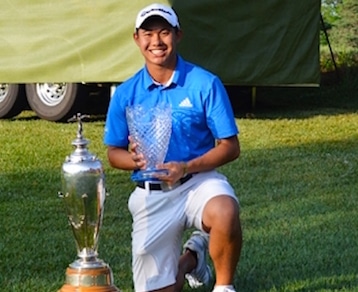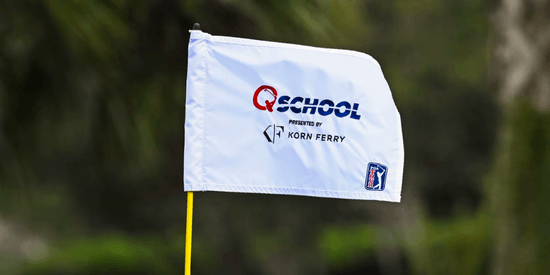Collin Morikawa looks to defend Trans-Mississippi title
7/11/2016 | by Trans-Mississippi Golf Association
see also: View results for Trans-Miss Amateur, Southern Hills Country Club

Famed Olympic Club to play host for 113th Trans-Miss Amateur Championship from July 12-14
This year’s Trans-Miss Championship features the strongest field in recent memory. Twenty-three of the world’s top-ranked amateurs, according to the World Amateur Golf Rankings, will compete on the iconic Lake Course at The Olympic Club. That decorated group of 23 inside the WAGR’s top 200 includes Stanford’s Maverick McNealy, the newly minted No. 1 amateur in the world after Jon Rahm turned professional last month.
“The Lake Course is one of my favorites in the area, if not my favorite,” said McNealy, the 2015 NCAA Player of Year who grew up about 30 minutes away from The Olympic Club. “It’s one of the best driving courses in the world. I love that it’s a local event. That’s huge.”
The format for the Trans-Miss Championship is 72 holes of stroke play over three days. After the first two days, there will be a 36-hole cut. Players with the 54 lowest scores (including ties) advance to the final day, in which 36 holes will be played to comprise the third and fourth rounds. The field also includes 10 players in the WAGR Top 100 and 14 in the top 150.
“We’re excited to take the Trans-Miss Amateur Championship to a historic venue like the Lake Course at The Olympic Club,” said Cameron Crawford, Tournament Director of the Trans-Miss Championship. “Numerous national championships have been decided on those hallowed grounds. It’ll be an exciting and memorable challenge for the talented field of amateurs in our event.”
The Olympic Club has played host to five U.S. Opens, including the 1955 affair that saw an unheralded Jack Fleck defeat Ben Hogan in an 18-hole playoff that is considered one of the great upsets in sports history. Most recently, Webb Simpson won the 2012 U.S. Open at The Olympic Club when he held off Jim Furyk and Graeme McDowell among others. The Lake Course also was the site of the Billy Casper’s 1966 U.S. Open victory, the one in which Arnold Palmer surrendered a seven-shot lead with nine holes to play. Scott Simpson and Lee Janzen also won U.S. Opens at The Olympic Club in 1987 and ’98, respectively.
The club additionally has hosted three U.S. Amateurs, two PGA Tour Championships, the 2004 U.S. Junior Amateur and last year’s inaugural U.S. Four- Ball Championship. It recently was awarded the 2021 U.S. Women’s Open. In 1958 at The Olympic Club, Charles Coe won the second of his two U.S. Amateurs. Coe, a four-time Trans-Miss Amateur Champion between the years 1947-56, is considered one of the greatest amateurs of all time. He never turned professional and holds or held nearly every amateur record at the Masters, including 15 made cuts, three top-10 finishes and six eagles.
Nathaniel Crosby, son of the celebrated singer and actor Bing Crosby, won the 1981 U.S. Amateur at The Olympic Club.
Tucked between Lake Merced and the Pacific Ocean, The Olympic Club boasts two 18-hole courses – the Ocean Course is the other – and an adjoining par- 3 course called the Cliffs. They’re all part of a bigger club by the same name. Located near Union Square in downtown San Francisco, The Olympic Club is the oldest athletic club in the country. Founded in 1860, the club has more than 5,000 members who compete in 19 sports from water polo and snowboarding to basketball, tennis and, of course, golf.
“Our philosophy of hosting amateur championships all comes from our athletic club downtown,” said Chris Stein, The Olympic Club’s Head Golf Professional since 1999. “Over the years, we’ve always wanted to foster amateur athletics. The U.S. Open became an opportunity for us, too, but we’ve always put an emphasis on amateur events.”
With the two major bodies of water close by, it’s a bit ironic that there are no water hazards on the Lake Course. There is a lateral hazard left of the 13th, 14th and 15th holes. There’s only one fairway bunker on the course; it’s on the par-4 sixth hole. Ranked inside Golf Magazine’s Top 100 and one of Golfweek’s Top 100 “Best Classic Courses,” the Lake Course features bentgrass greens and fairways with rye, bent and poa annua grasses. The course was designed in 1927 by then-superintendent Sam Whiting.
Interestingly, current superintendent Troy Flanagan is a former Trans-Miss Golf Association scholarship recipient. Trans-Miss Golf Association Directors Bob Ireland and Mark Mance are members of The Olympic Club, both of whom will be involved among fellow Directors in this year’s championship.
The Lake Course’s defense comes in the form of towering Monterey pines and cypress trees – nearly 40,000 of them – as well as narrow fairways, thick rough and sharp doglegs. The severe undulation throughout the course produces copious uphill, downhill and side-hill lies. There’s also the weather to consider.
“We are seaside, so there’s cooler weather even though it’s July,” Stein said. “You could get some fog, which makes for heavy air. The ball isn’t going to travel as far. You always have to take about a half-club more. You also have to take a look at your lie in the fairway. We have a lot of undulation, and the slopes out there can cause havoc.”
McNealy said he’s played the Lake Course 10 or 15 times. He said playing a home game will be an advantage for him in many respects. Sleeping in his own bed is a big one, as are playing in his normal time zone and the familiarity he has with the golf course, types of grasses and weather. McNealy’s love affair with the Lake Course began many years ago, and said there’s not one weak hole on the property.
“I think they’re all great holes,” said McNealy, who has won 10 events in his first three years at Stanford. He’s one collegiate victory behind the school record shared by Tiger Woods and Patrick Rodgers. “If you see someone getting out of the first six holes at even par, they’re going to be in great shape. The first six holes are brutal. You have to control the shape of your shots, the trajectory and how it lands, too. That’s why it’s such a great driving course.”
Collin Morikawa of La Cañada Flintridge, Calif., won the 112th Trans-Miss Championship by seven shots with a final score of 18-under-par 262 at Flint Hills National in Andover, Kan. A sophomore at California-Berkeley, Morikawa will defend his title at The Olympic Club. He rides into the Trans-Miss Championship on heavy wave of momentum. After a three-shot victory in mid-June at the Sunnehanna Amateur, he took runner-up honors at the Web.com Tour’s Air Capital Classic in Wichita, Kan. Morikawa scored the Web.com Tour event exemption by virtue of his victory at the 112th Trans-Miss Championship.
Morikawa, 19, drained a 35-foot birdie putt on the 72nd hole to post 17-under par and advanced to a three-man playoff at Crestview CC. He ultimately lost on the second playoff hole to Ollie Schniederjans. Morikawa almost joined Russell Henley (2011), Harris English (2011) and Daniel Summerhays (2007) as the only amateurs to win a Web.com Tour event.
The Trans-Miss Championship is one of three annual championships conducted by the Trans-Miss Golf Association. In May, Tommy Brennan from Louisiana won the Trans-Miss Senior Championship at Houston Country Club. The Trans-Miss Four-Ball Championship is set to be contested Sept. 26-29 at Forest Highlands in Flagstaff, Ariz.
Results: Trans-Miss Amateur
| Place | Player | Location | Pts | Scores |
|---|---|---|---|---|
| 1 | Plano, TX | 1200 | 66-65-74-69=274 | |
| 2 | , Australia | 900 | 68-70-67-70=275 | |
| 3 | Arlington Heights, IL | 700 | 71-67-69-71=278 | |
| T4 | Boca Raton, FL | 700 | 74-71-70-65=280 | |
| T4 | Honolulu, HI | 700 | 68-69-77-66=280 |
About the Trans-Miss Amateur

The Trans-Miss is one of the oldest and most storied golf tournaments in the United States. For 106 years the championship was played in a match play format. Past champions include Jack Nicklaus (1958 and 1959), Charles Coe (1947, 1949, 1952 and 1956...
Most Popular Articles

2025 PGA TOUR Q-School Guide: Sites, Scores, and Who Advanced
Dec 5, 2025Second Stage is complete and Final Stage awaits at Sawgrass — follow every Q-School leaderboard and the players still chasing
2025 LPGA TOUR Q-Series: Final Qualifying Stage FINAL SCORING
Dec 8, 2025Helen Briem earns medalist honors, 31 players headed to the LPGA next year
Australian Open at Royal Melbourne: Preview, amateur bios, and how to watch
Nov 30, 2025Rory McIlroy headlines one of the championship's top fields in years - at least four amateurs will have their chance at glory
Luke Ringkamp Cruises to Rolex Tournament of Champions Title at TPC San Antonio
Nov 26, 2025One week after committing to Pepperdine, Luke Ringkamp won the Rolex Tournament of Champions by nine shots.Inside Gil Hanse’s Restoration of Baltusrol’s Upper Course: A Return to Tillinghast’s
Dec 11, 2025Renowned architect Gil Hanse reveals how he brought Baltusrol’s Upper Course back to life by honoring A.W. Tillinghast’s original
